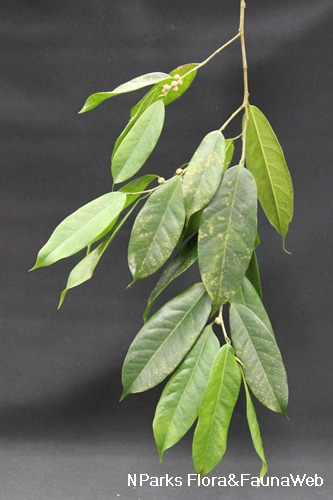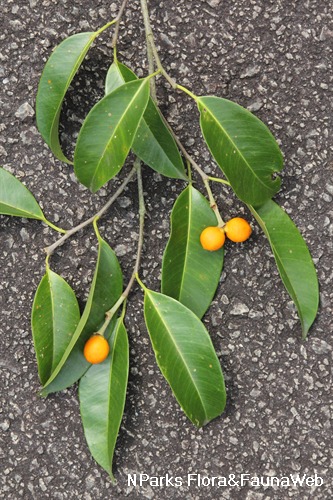
Name
Classifications and Characteristics
| Plant Division | Angiosperms (Flowering Seed Plants) (Dicotyledon) |
|---|---|
| Plant Growth Form | Climber |
| Lifespan (in Singapore) | Perennial |
| Mode of Nutrition | Autotrophic |
| Plant Shape | Irregular |
Biogeography
| Native Distribution | From northeastern India, Andaman Islands to southern China, Myanmar, Indochina, Thailand, throughout Malesia (including Singapore), and Micronesia |
|---|---|
| Native Habitat | Terrestrial (Primary Rainforest, Mountain, Secondary Rainforest, Freshwater Swamp Forest) |
| Preferred Climate Zone | Tropical |
| Local Conservation Status | Native to Singapore (Endangered (EN)) |
Description and Ethnobotany
| Growth Form | It is a root climber. |
|---|---|
| Foliage | Its alternate, stalked leaves have leathery leaf blades that are oval to egg-shaped with a round to heart-shaped base, dark green above, lighter green below, and 4–30 by 1.5–14 cm. The leaf blades are long arrow-shaped and covered with hair below when young. |
| Flowers | The plant is dioecious with each plant bearing male or female flowers. The flowers are tiny and develop within the syconium (fig). |
| Fruit | Its round syconia (figs) have characteristically long necks that resemble a part of the stalk. The syconia are up to 2 cm wide, bright red or purple when ripe, and develop singly, or in pairs, and occasionally in clusters in the leaf axils. |
| Habitat | It climbs on trees in lowland and montane forests up to 1,500 m altitude. It occurs locally in the Nee Soon Swamp Forest, Bukit Kallang, along Rifle Range Link, in the vicinity of MacRitchie Reservoir, along Napier Road, and Pulau Tekong. |
| Associated Fauna | Its flowers are pollinated by fig wasps. The ripe fruits are eaten by frugivorous birds and mammals. |
| Cultivation | It can be propagated by seed or stem cuttings. |
| Etymology | Latin Ficus, the commercial edible fig (Ficus carica); Latin sagittata, arrow-shaped, referring to the arrow-shaped base of its young leaves |
Landscaping Features
| Landscaping | It may be suitable for parks and gardens. |
|---|---|
| Desirable Plant Features | Ornamental Foliage |
| Landscape Uses | General, Parks & Gardens, Small Gardens |
Fauna, Pollination and Dispersal
| Fauna Pollination Dispersal Associated Fauna | Bird-Attracting (Fruits) |
|---|---|
| Pollination Method(s) | Biotic (Fauna) (Insects (Ant, Beetle, Fly, Thrip, Wasp)) |
| Seed or Spore Dispersal | Biotic (Fauna) (Vertebrates (Bat), Vertebrates (Other Mammal)) |
Plant Care and Propagation
| Light Preference | Full Sun, Semi-Shade |
|---|---|
| Water Preference | Moderate Water |
| Rootzone Tolerance | Moist Soils, Well-Drained Soils |
| Propagation Method | Seed, Stem Cutting |
Foliar
| Foliage Retention | Evergreen |
|---|---|
| Mature Foliage Colour(s) | Green |
| Mature Foliage Texture(s) | Leathery |
| Young Flush Texture(s) | Hairy / Hirsute |
| Foliar Type | Simple / Unifoliate |
| Foliar Arrangement Along Stem | Alternate |
| Foliar Attachment to Stem | Petiolate |
| Foliar Shape(s) | Non-Palm Foliage (Ovate, Elliptical) |
| Foliar Venation | Pinnate / Net |
| Foliar Margin | Entire |
| Foliar Apex - Tip | Acute |
| Foliar Base | Rounded / Obtuse, Cordate, Sagittate |
Floral (Angiosperm)
| Flower & Plant Sexuality | Unisexual Flowers , Dioecious |
| Flower Grouping | Cluster / Inflorescence |
|---|
| Flower Location | Axillary |
| Inflorescence Type | Syconium |
Fruit, Seed and Spore
| Mature Fruit Colour(s) | Purple, Red |
|---|---|
| Fruit Classification | Multiple Fruit |
| Fruit Type | Fleshy Fruit , Accessory / False Fruit (Pseudocarp) |
Image Repository
Others
| Master ID | 31196 |
|---|---|
| Species ID | 5590 |
| Flora Disclaimer | The information in this website has been compiled from reliable sources, such as reference works on medicinal plants. It is not a substitute for medical advice or treatment and NParks does not purport to provide any medical advice. Readers should always consult his/her physician before using or consuming a plant for medicinal purposes. |







.jpg)
